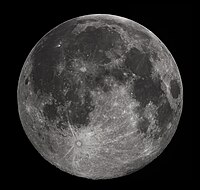
Photo from wikipedia
During the total solar eclipses on 11 August 1999 in Kecel (Hungary) and on 29 March 2006 in Side (Turkey), two Hungarian groups performed full-sky imaging polarimetric measurements of the… Click to show full abstract
During the total solar eclipses on 11 August 1999 in Kecel (Hungary) and on 29 March 2006 in Side (Turkey), two Hungarian groups performed full-sky imaging polarimetric measurements of the eclipsed sky. They observed the spatiotemporal change of the celestial polarization pattern and detected three polarization neutral points as well as two points with maximal polarization of the sky. Parallel to these studies, the polarization pattern in front of the lunar disc, the solar corona, and the surrounding sky have also been measured. During the total solar eclipse on 21 August 2017 in the USA (Rexburg-Idaho, Madras-Oregon), three American/international groups have measured the polarization characteristics of the full sky and the solar corona. The first group observed the spatiotemporal variation of the celestial polarization pattern, and the second group detected three polarization neutral points of the sky and observed two neutral points of the solar corona. The latter were named as Minnaert and van de Hulst neutral points. The third group observed two neutral points of the lunar disc. We have reanalyzed the earlier polarization patterns of the lunar disc, solar corona, and the surrounding sky measured during the Hungarian total eclipse on 11 August 1999. In these reanalyzed polarization patterns, all four neutral points observed during the eclipse on 21 August 2017 in the USA occur: the Minnaert/van de Hulst neutral point pair above/below the eclipsed Sun, where coronal polarization is canceled by sky polarization, and the northern and southern (unnamed) neutral points of the lunar disc, where the directions of polarization of coronal light and foreground skylight are perpendicular to each other with the same polarized intensity. We name the latter two polarization neutral points after Coulson and Vorobiev.
Journal Title: Applied optics
Year Published: 2021
Link to full text (if available)
Share on Social Media: Sign Up to like & get
recommendations!